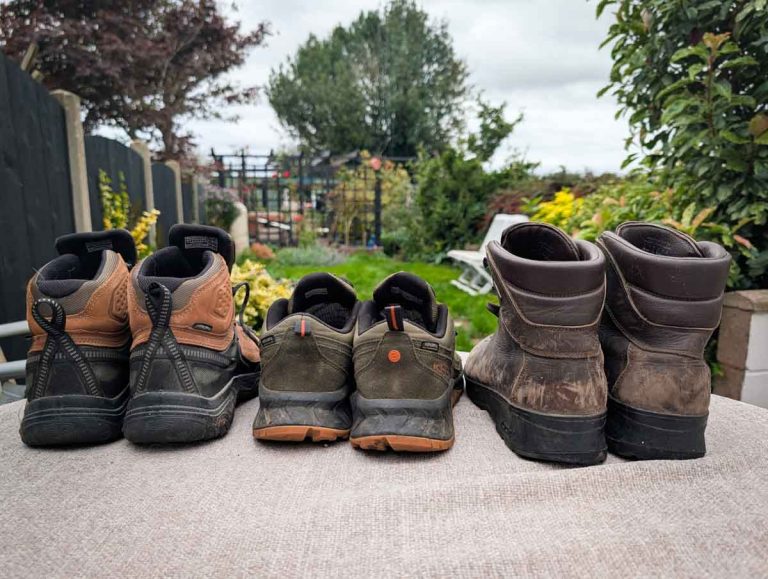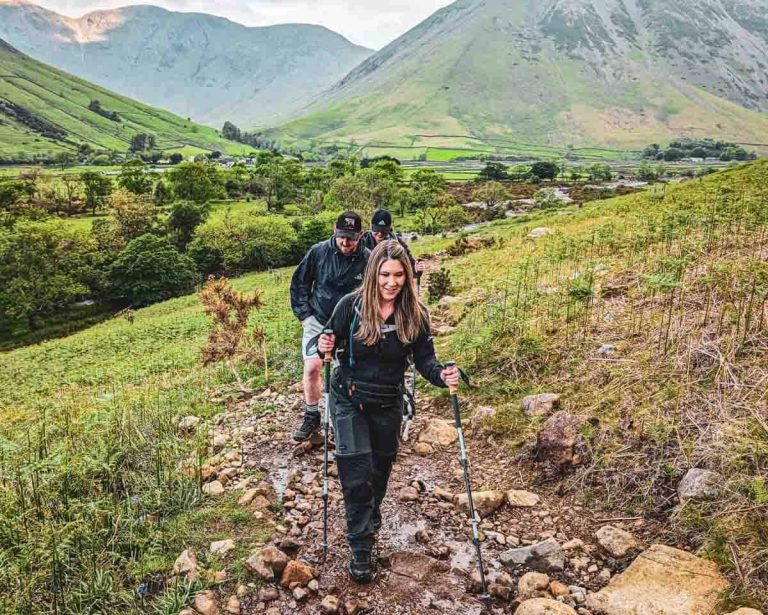When embarking on a hiking adventure, one of the most crucial pieces of gear to consider is the hiking jacket. Among the many features that a good hiking jacket should possess, waterproofness stands out as a top priority.
And if, like me, you have hiked a lot in the UK then you will put waterproofness high on your list of needs. It is great to get out on the trails in all kinds of weather, but if you get wet then it gets unpleasant, and potentially dangerous.
When I take groups on the guided hikes in the fells and peaks of the Lake District and Yorkshire Dales I have a duty to look after people.
It can quite often be raining, sometimes very heavy. Many people attending the walks may be new to the outdoors so guiding them on correct jackets needed for the job is essential.
You may think all rain jackets are created almost equal, they are definitely not. In some cases you get what you pay for.
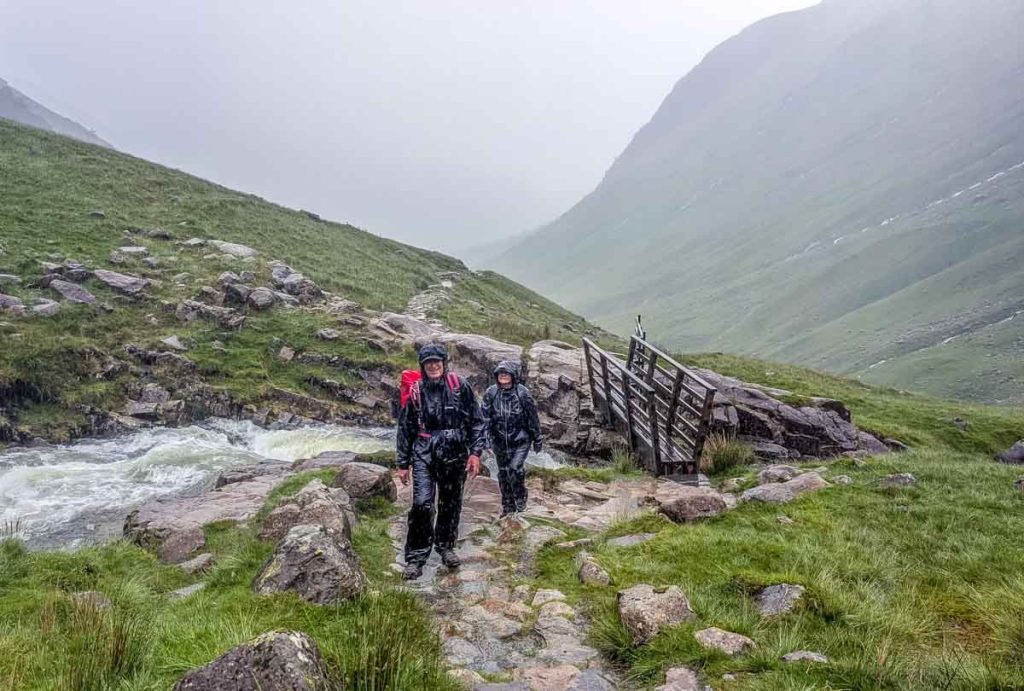
Online stores use all kinds of technical terms to market their waterproof jackets but some may only be good for light rain and only a few are good for really heavy rain on the mountains.
In some uses a water resistant jacket is fine, but in plenty of hiking cases a good, solid waterproof is required.
When you see a product description for a jacket for sale there are certain numbers and ratings that you should be looking for within the marketing ping words. Numbers that show how waterproof they are, how breathable they are and they should show how well protected the seams are.
Here now, I want to exlpore the concept of waterproofness in hiking jackets, exploring its significance, the various materials used, the testing methods to ensure effectiveness, and how to select the right jacket for your needs. Plus the levels of waterproofness.
There is a lot more to it than you think.

Importance of Waterproofness for Hikers
Waterproofness, naturally, is essential for hikers as it directly affects comfort and safety in varying weather conditions. Rain, snow, or even high humidity can lead to discomfort, hypothermia, or even dangerous situations if your clothing fails to protect you.
A waterproof jacket ensures that moisture from the outside cannot penetrate, keeping you dry and allowing for proper body temperature regulation. This function is particularly vital in unexpected weather changes that are common in mountainous or forested regions.
Moreover, the importance of waterproof jackets extends beyond mere comfort. Staying dry can significantly impact your energy levels during a hike. Wet clothing can lead to chafing, increased weight, and a drop in morale.
A well-designed waterproof jacket enhances your overall hiking experience, allowing you to focus on the trail rather than the discomfort of being soaked through.
Overview of Hiking Jacket Types
There are several types of hiking jackets available on the market, each designed for specific conditions and activities.
The primary categories include hard shells, soft shells, and insulated jackets.
Hard shell jackets are typically fully waterproof, providing a barrier against rain and wind, ‘usually’ making them ideal for heavy downpours and extreme conditions.
Soft shell jackets, on the other hand, offer more breathability and are usually water-resistant rather than fully waterproof; they are suitable for lighter rain and active pursuits.
Insulated jackets combine waterproof properties with additional warmth, making them perfect for colder climates. These jackets can often feature a waterproof shell along with insulation materials to keep the wearer warm.
However, an easy trap that people fall into is assuming every hard shell is good waterproof. There are many levels of waterproofing and every brand can do this in differing ways.

Definition of Waterproof and Water-Resistant
The terms waterproof and water-resistant are sometimes used interchangeably, but they denote different levels of protection.
Waterproof means that no water can penetrate the fabric, even under pressure. This is essential for heavy rain and wet conditions.
Water-resistant, however, implies that the fabric can resist some water but is not entirely impervious. It may withstand light rain or splashes but may fail under prolonged exposure to moisture. Another phrase you may hear in this category is showerproof.
For hikers, understanding the difference is vital. A truly waterproof jacket will keep you dry in the harshest conditions, whereas a water-resistant jacket may suffice for short walks in mild rain but could leave you vulnerable during serious downpours.
Waterproof Ratings Explained
Waterproof jackets are most often rated based on a Hydrostatic Head (HH) measurement, which quantifies how much water pressure a fabric can withstand before leaking. This water pressure is measured in mm.
If you look at a good waterproof jacket in a store it will often have its HH measurement printed on it or on its label somewhere.
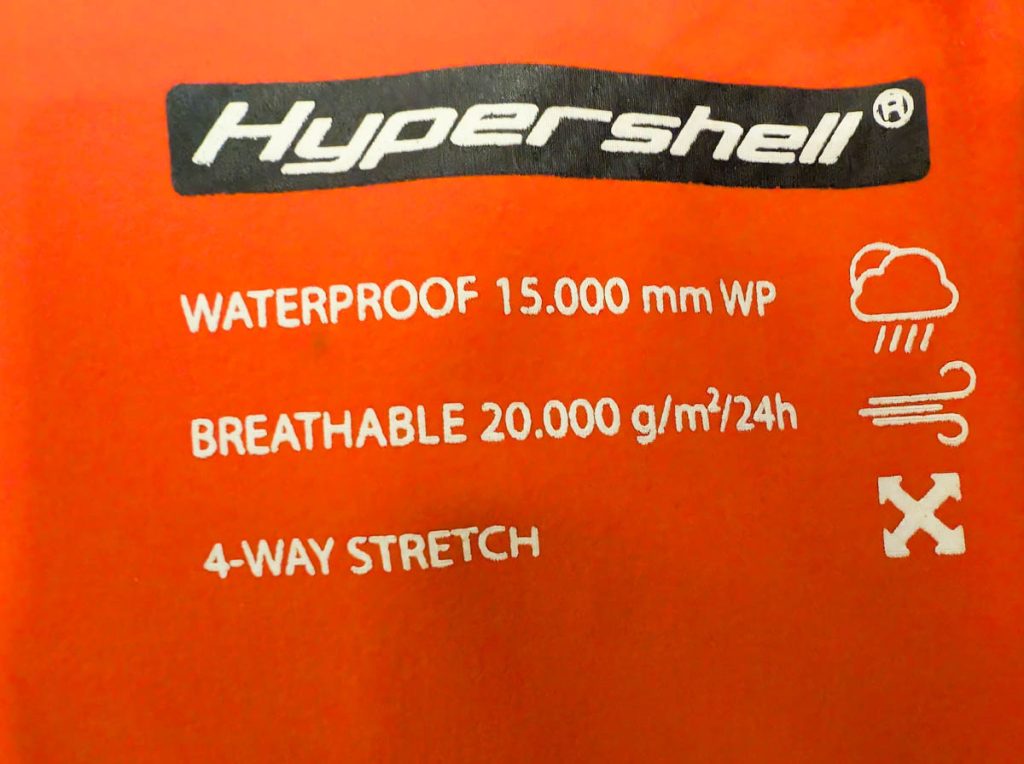
To get the HH level in a lab, a piece of the fabric is stretched, airtight, around the bottom of a 10cm circumference tube. Water is then added until you have the level in mm that it starts to leak. Thus showing how waterproof that fabric is.
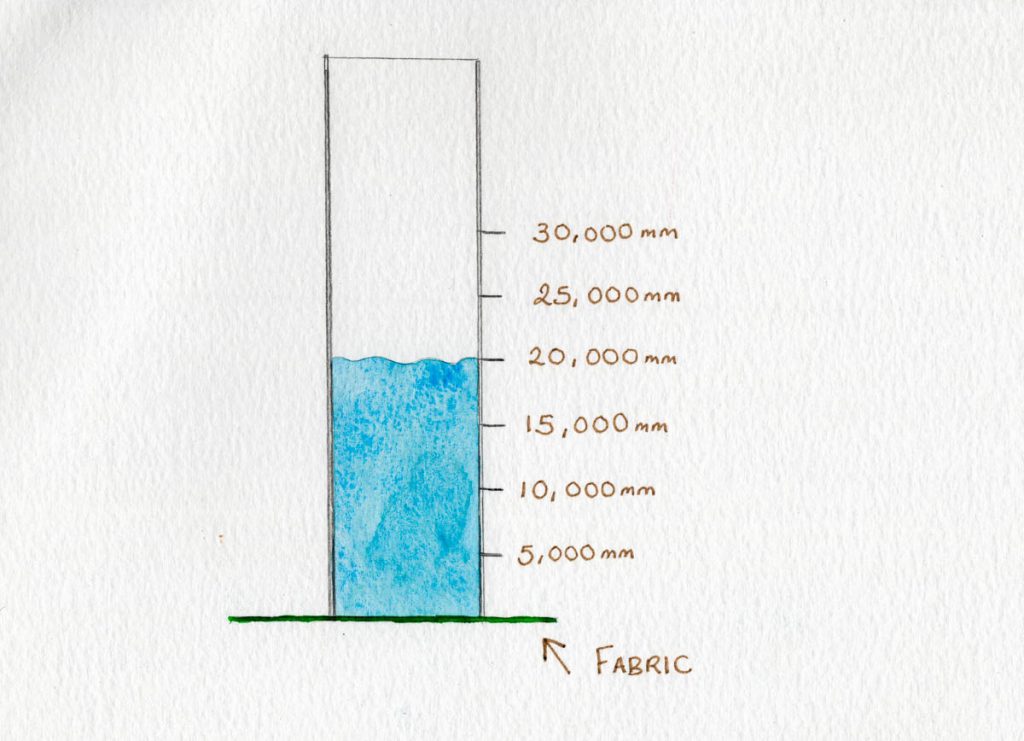
Common ratings include 5,000 mm, 10,000 mm, and up to 20,000 mm or more. Here is a rough guide to what these numbers mean to you.
- 5,000 – 10,000mm HH – Great for the odd shower and some light rain or snow but not the best for hiking in continuous rain.
- 10,000 – 20,000mm HH – A great all rounder for moderate rain and normal outdoor activities.
- 20,000mm HH Plus – This is for extreme weather and heavy rain or snow. Covers you for highest pressure level of water.
This can be the issue when buying a waterproof hiking jacket. If you buy a big brand jacket yet it is only 10,000mm HH you are going to get wet if you head into the fells on a day of continuous rain.
For example, I have 2 waterproof jackets from RevolutionRace. Both look great and well made. Advertised as great jackets in rain.
The green jacket is 15,000 mm HH. The orange jacket is 20,000 mm HH. If I am off on a hike in the Lake District and the weather looks bad for rain then I will take the orange hard shell one.

Why would I use the green one ever in that case I hear you ask? Well that comes with the better breathability rating and wanting not to get wet with sweat. Balancing the fine line between waterproofness and breathability.
The ultimate waterproof jacket would be a rubber suit! But you most defintely would get very wet with sweat.
I find with most brands, that the higher the waterproof rating, the less you get in breathability. Gore-Tex have super fabrics and science that help with this. Hence the higher price as well as popularity by those in the know.
Breathability Ratings Explained
OK, so in addition to hydrostatic head ratings, breathability is another crucial facet that often pairs with waterproof ratings.

A jacket must not only keep rain out but also allow sweat to escape to maintain comfort during physical activity.
So much science is used to create fabrics that allow maximum waterproofing whilst allowing good breathability. Basically a material that does not allow water in but has small enough pores that still allows water out.
So how is the breathability of a hiking jacket measured and what do the numbers mean? Well they normally use a figure called the Moisture Vapour Transmission Rate (MVTR).
The MVTR is annotated as grams per square metre per day (g/m2/24h). The higher the number the more breathable it is and more suitable for higher exertion activities etc. A rough guide being:
- 5000 g/m2/24h – Good for when standing around more and not moving much.
- 10,000 to 15,000 g/m2/24h – Good for normal outdoor activities like day walk and slow hill climbing.
- 20,000 g/m2/24h – Good for strenuous hikes where you are sweating a lot.
With the 2 ratings guides above you can see how all hiking jackets are made for certain strengths. You may get a jacket that is very high waterproof yet hardly breathable. On the other hand you may get a good breatable waterproof jacket but its waterproofness will only take you so far.
Why You Often Get Wet Shoulders First
Have you ever worn a good waterproof hiking jacket then in a downpour your shoulders start to get wet? You question the jacket, you think about a leak?
This is most often due to backpacks together that HH level and water pressure rating. Rucksack straps add pressure to the shoulders and thus also the water upon the fabric. Hence the fabric will leak faster than without a rucksack.

Reading Online Reviews
I see it often in online reviews of jackets. People complaining that the jacket was not waterproof. It may well be as advertised though and may well be priced accordingly.
A mid priced jacket rated 10,000 HH for waterproof and 20,000 g/m2/24h for breathablity would say to me that if there is some rain around, a few showers, when I am on a long long hike this jacket would be great. Enough waterproofing and excellent breathability so I won’t sweat too much.
However if there is a prolonged heavy downpour then I should expect at some point for it to leak.
Beware the cheap waterproofs too. Light ponchos and cheap waterproof jackets may have just a 2,000 HH rating or so as well as low breathability. Not great if your outdoor hobby is more serious.
Factors Influencing Waterproof Performance
Understanding DWR (Durable Water Repellent)
You have your shiny new jacket and it gets its first shower of rain upon it. Do you notice it forms pearls of water that run ff the fabric? A bit like when rain hits a newly waxed car.
Well that is caused by the DWR (durable Water Repellent). A coating that is added to the outer layer of the fabric as a first line of defence against rain.
However just like with the car wax, as the jacket gets dusty, dirty, worn and stuffed into bags then it loses its waterproof quality.
Especially for a prized or expensive waterproof jacket I would ‘reproof’ this DWR coating at regular intervals, especially when you lose some waterproofness. You can tell when the jacket absorbs splashes of water rather than creating those pearls.
The most common types are wash in or spray on.
Seams and Construction
While the fabric of a jacket plays a pivotal role in waterproofness, the construction quality is equally vital. Seams are often the weak points where water can infiltrate. Techniques such as taping, sealing, or welding seams enhance a jacket’s waterproof capabilities by preventing moisture from leaking through these vulnerable areas.
Additionally, features such as adjustable cuffs, storm flaps, and adjustable hoods can further enhance waterproof performance by creating barriers that restrict water entry. Ensuring these elements are well-designed can make a significant difference in overall durability and comfort.
Membrane Technology
Membrane technology is a popular choice for high-performance waterproof jackets. The most recognized membrane is Gore-Tex, which features microscopic pores that are small enough to block water droplets but large enough to allow water vapor to escape, ensuring breathability. Other brands, such as eVent and Futurelight, utilize similar technologies to provide effective waterproofing while maintaining airflow.
These membranes are often bonded to other fabric layers, providing durability and enhanced comfort. When choosing a jacket with membrane technology, it’s essential to consider not only the waterproof rating but also how the product performs in real-world conditions.

Choosing the Right Waterproof Jacket
Activity Type Considerations
Different hiking activities demand different features in a waterproof jacket. For example, if you plan to go on a challenging multi-day hike, investing in a high-quality, durable hard shell jacket with excellent waterproof and breathability ratings is advisable. Conversely, for casual day hikes or less physically demanding activities, a lightweight, water-resistant soft shell may suffice.
Additionally, consider the type of terrain and weather conditions you will encounter. For instance, if you’re hiking in a region known for sudden storms, a fully waterproof jacket with features like a helmet-compatible hood and reinforced elbows may be necessary. Understanding the specific requirements of your hiking activities will help narrow down your options efficiently.
Weather Conditions
Weather conditions play a significant role in choosing a waterproof jacket. For wet climates with constant rain, a high hydrostatic head jacket with advanced membrane technology is essential. In contrast, if you’re hiking in drier conditions but still expect moisture, a water-resistant jacket may be all you need.
Climate also influences the choice of insulation. In colder weather, jackets that offer both waterproofness and insulation are preferred to keep the body warm while protecting against precipitation. In warmer conditions, breathable, lightweight jackets that allow for ventilation are ideal.
Fit and Comfort
A well-fitting jacket is crucial for both performance and comfort. Ensure that the jacket allows for a full range of motion, especially if you plan to engage in activities such as climbing or scrambling. Consider features like adjustable cuffs, hems, and hoods for a personalized fit that can accommodate layers underneath without restricting movement.
Moreover, try on jackets with the base layers you’ll wear while hiking. This ensures that you choose a size that allows for ample layering in colder conditions while still remaining comfortable during warmer hikes. Remember, the right fit enhances comfort and simplifies the overall experience on the trails.
Storage Tips
When not in use, how you store your waterproof jacket can impact its longevity. Avoid compressing the jacket for extended periods, as this can damage the fabric and diminish its waterproof capabilities. Instead, store it in a dry and cool place, ideally hanging it up rather than folding it, to maintain its shape and integrity.
Additionally, ensure that your jacket is completely dry before storing it to prevent mold and mildew growth, which can ruin the fabric and compromise its performance. Proper storage is an often-overlooked aspect of maintenance that can prolong the life of your jacket significantly.
Conclusion
Waterproofness is a critical feature in hiking jackets, playing a key role in keeping you dry and comfortable in various weather conditions.
Understanding the difference between waterproof and water-resistant materials, as well as the various types of fabrics available, is essential for making an informed purchase.
Additionally, factors like seam construction, breathability, and maintenance practices all contribute to the jacket’s overall performance.
I find that you get what you pay for when it comes to hiking jackets. A lot of science has gone into jackets that are truly waterproof for the mountains.
FAQs
What is the difference between waterproof and water-resistant jackets?
Waterproof jackets are designed to keep you dry in heavy rain and wet conditions, while water-resistant jackets can only withstand light rain or splashes. Waterproof jackets typically have higher hydrostatic head ratings and feature better sealing technologies.
How do I clean my waterproof jacket?
To clean your waterproof jacket, use a gentle detergent specifically made for technical fabrics. Always follow the manufacturer’s washing instructions to avoid damaging the jacket’s waterproofing capabilities.
Can I wear my waterproof jacket in warm weather?
Yes, you can wear a waterproof jacket in warm weather, especially if it is breathable. Look for jackets that offer ventilation features to help regulate temperature and moisture buildup.
How often should I reproof my waterproof jacket?
It is generally recommended to reproof your waterproof jacket after several washes or whenever you notice that water no longer beads off the surface. Regular reproofing helps maintain its water-repellent properties.
What should I look for when choosing a waterproof jacket for hiking?
When selecting a waterproof jacket for hiking, consider factors such as the type of activity, expected weather conditions, fit, and comfort. Additionally, pay attention to the materials, waterproof ratings, breathability ratings and construction quality.




